With their bright white flowers, the Deutzia not only impress visually, but are also very popular with insects thanks to their nectar and pollen. The many attractive Deutzia varieties are also easy to care for.
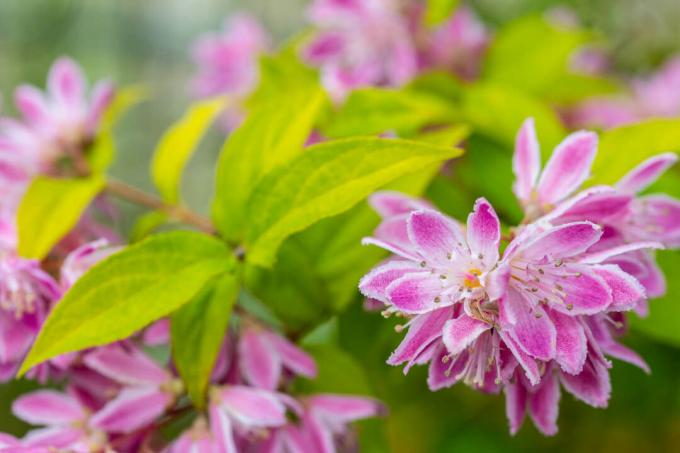
The Deutcia (Deutzia) is particularly noticeable thanks to its considerable number of flowers. Due to the shape of the flower and the flowering time, it is also called a star bush or May flower bush. The Deutzia is often used in hedges as it is both decorative and robust and easy to care for.
contents
- Deutzia: flowering period, origin and characteristics
- The most beautiful Deutzia varieties and species
- Plant Deutzia: This is important to note
-
The most important care measures
- Water and fertilize the mayflower bush
- Cut Deutzia
- multiply deutzia
- Deutzia hibernate
- Are deutcia poisonous?
Deutzia: flowering period, origin and characteristics
The Deutcia (Deutzia) is an ornamental plant that is often cultivated as a shrub. The hydrangea (Hydrangeae) originally comes from East Asia and is native to the Himalayas and the Philippines. A few species have their origins in Mexico. There are about 50 wild species in total. Of these naturally occurring species found only the
Deutzia gracilis – also called Petite Deutzia – made their way to Europe. Most other garden Deutzia are predominantly crossbred cultivars, many of which derive from the work of French breeder Lemoine.The Deutzia has its flowering period from May to June and then it cannot be overlooked with its countless star-shaped flowers in white or pink. The flowers are in long panicles, racemes or umbrella panicles. The Deutzia is also bee-friendly: with its magnificent flowers, it is popular with bees, bumblebees and other wild bee species as it offers them a lot of food.
Depending on the variety, Deutzia can grow between 0.8 and 4 meters tall. The contrasting, rich green leaves are ovate, tapering and toothed. The brown capsule fruits are rather inconspicuous and usually stay on the branches until next spring.
Most Deutzia look very similar and also to the pipe tree (Philadelphus) there are only minor distinguishing features. However, all Deutzia have hollow shoots on the inside, while the shoots of the phoniae contain white pith.
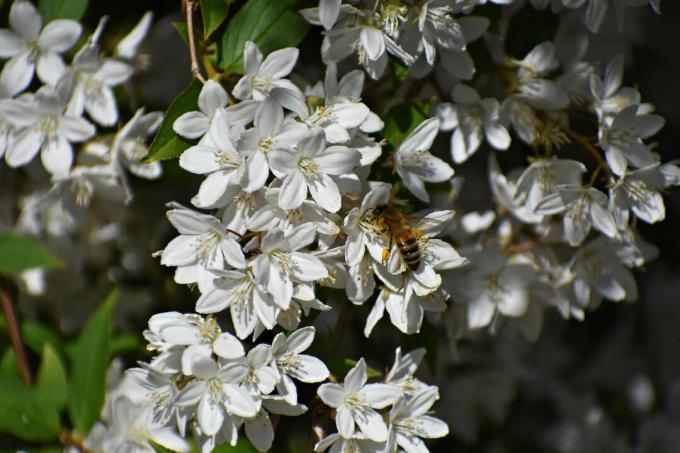
Tip: There are also filled deutcia such as the rough deutcia (Deutziascabra ‘plenary’). These are not bee-friendly, as the pollen and nectar-giving sex organs are transformed into additional, decorative petals.
The most beautiful Deutzia varieties and species
There are a large number of beautiful Deutzia varieties, so that there is a suitable specimen for almost every garden.
- Petite Deutzia (Deutzia gracilis): The best-known Deutzia is one of the dwarf varieties and, with its 70 - 90 cm, also fits into smaller gardens or as a container plant on the balcony. It has countless small, pure white flowers.
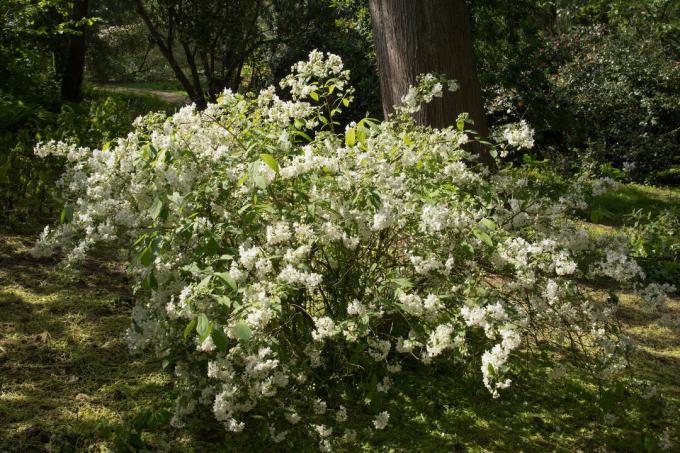
- Tall Mayflower Bush (Deutzia x magnifica): Also known as high starlet shrub, it can grow up to 4 m high and about 2 m wide when free-standing. It grows quickly and can be used as a hedge plant.
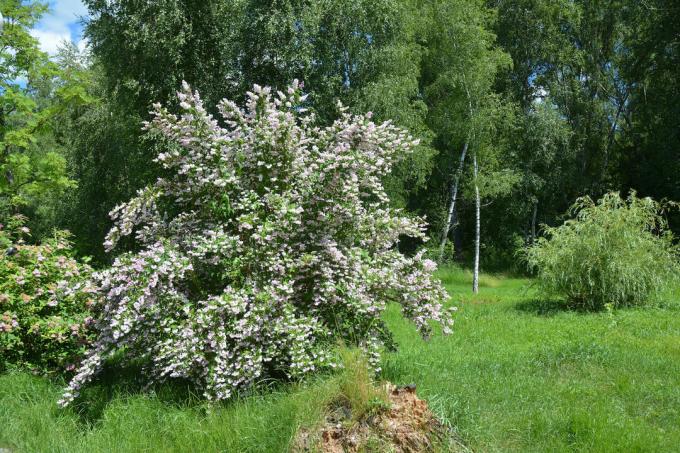
- Strawberry-scented Deutzie (Deutzia hybrida ‘Strawberry Field’): This strain has pink flowers that give off a slightly sweet strawberry scent. The strawberry-scented Deutzia is one of the early bloomers, as it blooms from April to May.

- Rough Deutzia (Deutzia scabra ‘plenary’): This Deutzia is also called a filled star bush. It is a popular ornamental plant solitary and in mixed hedges. Its double flowers look very magnificent and voluminous.

- Kalmia Deutzia (Deutzia x squid flora): This species reaches a height of 150 cm and convinces with a rich display of white-pink flowers that appear in June.
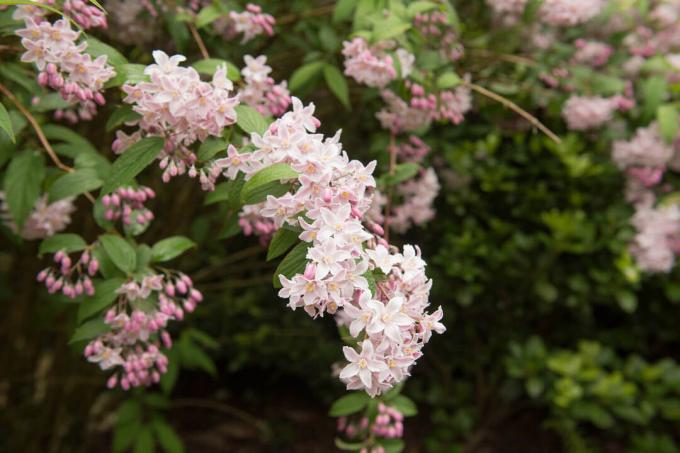
- Deutzia ‘Tourbillon Rouge’ (Deutzia x magnifica ‘Tourbillon Rouge’): This is a variety of the tall star bush. It grows to about 3 meters tall and has deep pink flowers.
Plant Deutzia: This is important to note
Planting a Deutzia is easy:
- Place the root ball in a bucket of water
- Dig a planting hole about 1.5 times the size of the root ball
- Improve the excavation with potting soil, for example with ours Plantura organic universal soil
- Fill in gaps with excavation and press down firmly
- Model the pouring edge and distribute the mulch layer
- Water well
The ideal time to plant a Deutzia is in September and October, as the warmed-up soil offers the best conditions for rooting. Depending on the variety, an appropriate distance to other plants must be maintained. Deutzia like wind-protected locations in the sun or in partial shade. The soil should be loose, humic, nutritious and slightly sandy. If the soil is very sandy or clayey, the soil should be mixed with high-quality substrate and thus upgraded. For example, ours is suitable for this Plantura organic universal soil, which can store water but does not get waterlogged. In addition, it provides the Deutzia with important nutrients and improves the soil properties in the long term.
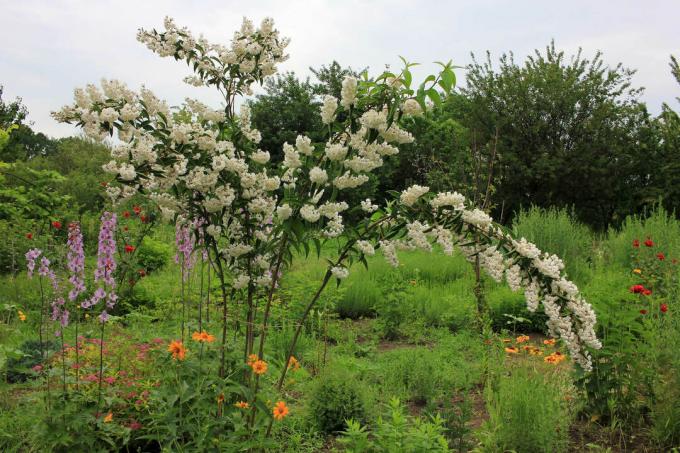
When planting a Deutzia hedge, it is particularly important to stick to the planting distance. This varies from variety to variety and is like dwarf varieties Deutzia gracilis at 30 cm. The high May flower bush needs a distance of 50 cm and the very wide spread Deutzia scabra even 100cm.
Tip: Deutzie in the bucket
short stature Deutzia- Varieties like Deutzia gracilis, Deutzia x squid flora or Deutzia x rosea can also be planted in a sufficiently large bucket with a volume of at least 50 litres. To avoid waterlogging, place clay discs as drainage between the substrate and the planter. Here offers our Plantura organic universal soil best conditions for lush growth.
The most important care measures
As a rule, Deutzia do not require demanding care. It is also not very demanding in terms of location and nutrient content. Rigorous pruning is required every two years to ensure consistently profuse flowering.
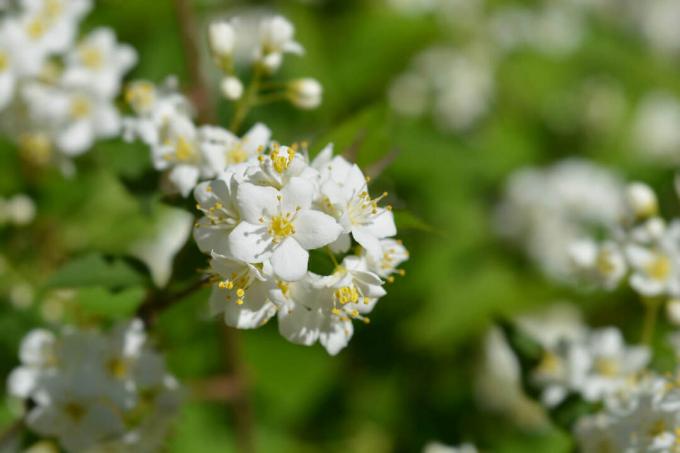
Water and fertilize the mayflower bush
Since Deutzia are very robust and undemanding, it only needs to be watered if the soil cannot hold the water well. If it is hot for a long time in summer and the soil feels dry, you can water the Deutzia seldom but extensively. The plant also signals a lack of water by drooping leaves. If the Deutzia grows in nutrient-poor soil, it should be treated once in spring with a long-term fertilizer, such as ours Plantura organic universal fertilizer, to be taken care of. Its balanced nutrient composition ensures healthy growth and supplies the Deutzia for at least three months. The high proportion of organic ingredients also promotes the activity of important soil organisms. Alternatively, a mixture of compost and horn shavings can be used.
Cut Deutzia
You should do this about every two years Deutzia cut. You can be generous here, because the Deutzia will then sprout all the more splendidly. The rejuvenation cut is particularly important as the Deutzia are not long-lived and also age quickly. Here the old wood is removed. You should cut off all old shoots as close to the ground as possible so that many new young shoots can be formed. The pruning can be done either after flowering or in spring or late winter. Although some buds are removed by pruning in spring, the Deutzia sprout more vigorously than after pruning in summer.
Tip: To encourage the Deutzia to bloom again in autumn, you can shorten the faded shoots above the buds by about a third in June and July.
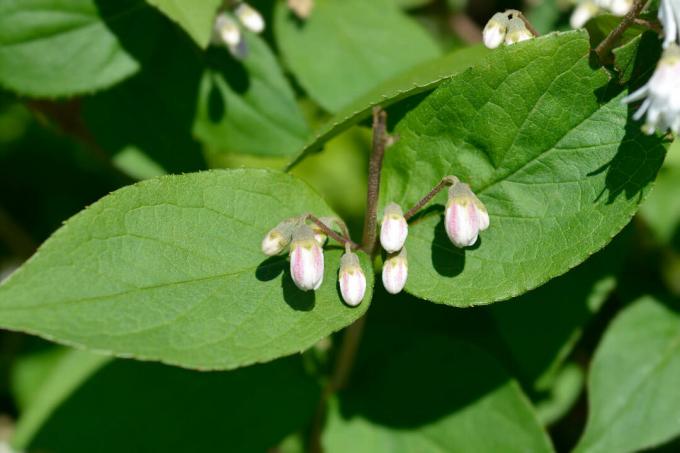
multiply deutzia
Propagation of cuttings with half-ripe shoots in late spring and early summer is particularly suitable for multiplying the Deutzia. For this you can cut about 8 cm long, green or slightly woody shoots with two leaf nodes (nodes). When you have removed the lower leaves, put the shoot in nutrient-poor potting soil, such as ours Plantura Organic Herb & Seed Soil. It contains no peat and is precisely tailored to the needs of young plants. Due to the low nutrient content, the small plants are encouraged to develop roots. Always keep the soil moist to allow roots to develop over the next 4 to 6 weeks. Make sure that the pot is not in direct sunlight, but is still bright.
Deutzia can also be propagated by sinkers. To do this, use one of the lower shoots of the mother plant and fix it in the ground. It is best to pile up some more soil on the spot you have set down so that many roots can form in the soil. After some time, the rooted shoot should be severed from its mother plant. This creates an independent plant that develops exactly the same properties as the mother plant. When planting in spring, it is important that no Deutzia has previously stood in the place, as they are incompatible with themselves. It usually takes a year for an independent plant to develop.

Deutzia hibernate
Deutzia are hardy and do not need winter protection. However, this does not apply to cuttings and potted plants. They need winter protection. To do this, you should wrap the planters twice with insulating materials such as foil, fleece, jute or coconut fiber. Then overwinter the cuttings in a cool and bright, but frost-free place.
Are deutcia poisonous?
Deutzia are not poisonous, but completely harmless for adults and children. The leaves, flowers and shoots do not contain any toxins, so you don't have to worry about your pets either.
Deutzia beautify hedges with their decorative flowers. But there are other plants that are considered flowering hedges can be used. We present twelve suitable and hardy plants.



